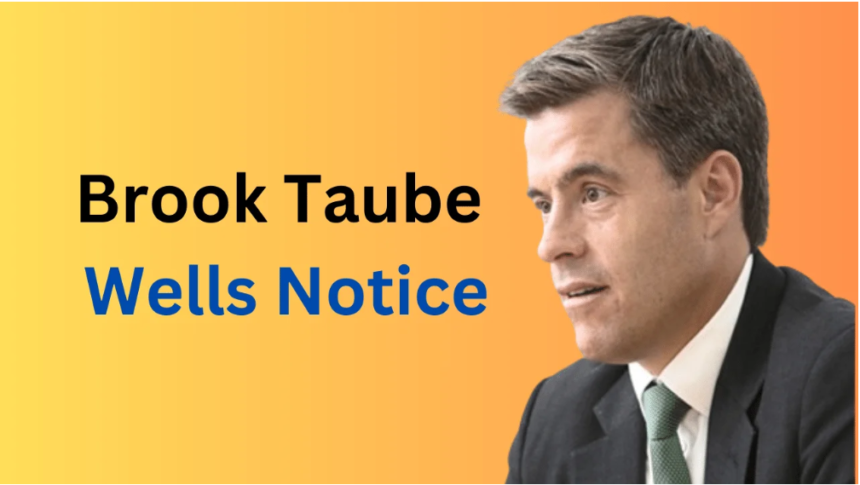Have you ever heard of a Brook Taube Wells Notice? If not, don’t worry – you’re not alone. In the intricate world of finance and securities regulation, receiving a Wells Notice can be a pivotal moment for individuals and companies alike. So, buckle up as we dive into this comprehensive guide to understanding what a Brook Taube Wells Notice is all about.
What is a Brook Taube Wells Notice?
A Brook Taube Wells Notice is a formal notification issued by the Securities and Exchange Commission (SEC) to individuals or entities indicating that the SEC staff is considering recommending enforcement actions. Essentially, it serves as a warning shot before any formal charges are filed. The notice outlines the potential violations of securities laws that have been identified during an investigation.
Receiving a Wells Notice can be alarming for recipients as it signifies that they are under scrutiny for possible misconduct in connection with securities regulations. It’s like a red flag signaling that serious legal consequences may be on the horizon if not properly addressed.
Brook Taube Wells Notices play a crucial role in the regulatory process by giving recipients an opportunity to respond to the allegations and present their side of the story before final enforcement decisions are made. This pre-enforcement stage allows individuals and companies to provide explanations, defenses, or additional information to potentially sway the outcome in their favor.
Understanding the Purpose of a Wells Notice
If you’ve ever heard of a Wells Notice, you might be wondering about its purpose. Essentially, a Wells Notice is issued by regulatory bodies like the SEC to inform individuals or entities that they are under investigation. It serves as a warning and an opportunity for the recipient to respond before any formal charges are brought against them.
The main goal of a Wells Notice is to give the recipient a chance to provide their side of the story and present any evidence or arguments in their defense. It helps ensure fairness and transparency in regulatory proceedings by allowing those involved to participate in the process and potentially avoid litigation.
Understanding the purpose behind a Wells Notice can help recipients navigate this challenging situation with more clarity and insight. It’s crucial to take this notice seriously and seek legal counsel if needed to effectively respond and protect your interests.
The Process of Receiving a Wells Notice
Receiving a Wells Notice can be a nerve-wracking experience for any individual or company involved in securities-related investigations. The process typically starts when the SEC staff believes there might have been a violation of securities laws and decides to issue a Wells Notice. This notice serves as a warning that the staff is considering recommending enforcement action.
Upon receiving the Wells Notice, recipients are given an opportunity to respond before any formal charges are filed. This response can be crucial in shaping the outcome of the investigation. Respondents usually have the chance to submit a written statement explaining their side of the story and addressing any allegations brought against them.
The process of receiving a Wells Notice often involves engaging legal counsel experienced in securities law to help navigate through this complex procedure. It’s essential for recipients to carefully review and understand the allegations outlined in the notice before formulating their response strategy.
Dealing with a Wells Notice requires careful consideration and strategic planning to ensure that all relevant information is presented effectively during this critical stage of an investigation.
Potential Consequences of Receiving a Wells Notice
Receiving a Wells Notice from the SEC can have serious consequences for individuals or entities involved in securities-related investigations. It serves as a warning that the SEC staff is considering recommending enforcement action, signaling potential legal trouble ahead.
The mere receipt of a Wells Notice can impact one’s reputation and business relationships even before any formal charges are brought. This early stage of the investigation can be emotionally taxing and financially draining due to legal costs and uncertainties about the future.
If not dealt with promptly and effectively, a Wells Notice could lead to regulatory sanctions, fines, civil penalties, or even criminal charges. The implications of mishandling this critical juncture in an investigation cannot be overstated.
Navigating through the complexities of responding to a Wells Notice requires strategic decision-making and expert legal counsel. Ignoring or downplaying its significance could exacerbate the situation further, potentially leading to more severe repercussions down the line.
Responding to a Wells Notice
Receiving a Wells Notice can be a daunting experience for anyone in the financial industry. It signifies that the Securities and Exchange Commission (SEC) is considering taking enforcement action against you. When you receive a Wells Notice, it is crucial to respond promptly and thoughtfully.
One important aspect of responding to a Wells Notice is gathering all relevant information and documents related to the matter at hand. This includes any communications, emails, reports, or other evidence that may be requested by the SEC. It’s essential to review these materials carefully before formulating your response.
When crafting your response, it’s vital to be honest and transparent with the SEC. Avoid withholding information or providing misleading statements as this could further complicate your situation. Consult with legal counsel to ensure that your response addresses all pertinent issues effectively.
Understanding the allegations outlined in the Wells Notice is key to formulating a strong response. Take the time to analyze the accusations against you thoroughly and provide clear explanations or defenses where necessary. By approaching your response methodically and diligently, you can potentially mitigate any negative consequences associated with receiving a Wells Notice.
Remember that how you respond to a Wells Notice can have significant implications for future proceedings with the SEC. Taking this process seriously and seeking appropriate guidance can make all the difference in how your case unfolds moving forward.
Tips for Dealing with a Wells Notice
When faced with a Wells Notice from the SEC, it’s crucial to approach the situation with care and precision. Here are some tips for dealing with this potentially challenging issue.
Remain calm and focused. Panicking or making hasty decisions can exacerbate the situation. Take the time to thoroughly review the notice and understand its implications.
Consult with legal counsel experienced in securities law. A knowledgeable attorney can provide valuable guidance on how to navigate the Wells process effectively.
Gather all relevant documents and information requested in the notice promptly. Organizing your materials efficiently will demonstrate cooperation and professionalism to the SEC.
Craft a well-thought-out response that addresses each point raised in the Wells Notice comprehensively. Be honest, transparent, and cooperative throughout your communication with regulatory authorities.
Stay proactive throughout the process. Keep abreast of any developments or requests from the SEC and be prepare to adapt your strategy accordingly.
Conclusion
Receiving a Wells Notice, such as the one issued by brook taube wells notice can be a daunting experience for any individual or organization. It is crucial to understand the purpose of the notice, the potential consequences it may entail, and how to effectively respond to it. By being proactive, seeking legal advice if needed, and cooperating with regulators during the process, you can navigate this challenging situation with care and diligence. Remember that transparency and compliance are key when dealing with regulatory inquiries. Stay informed, stay prepared, and handle Wells Notices with professionalism and integrity.







